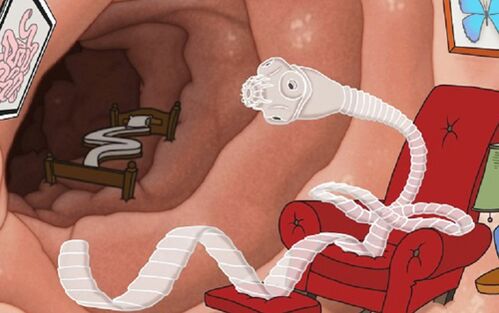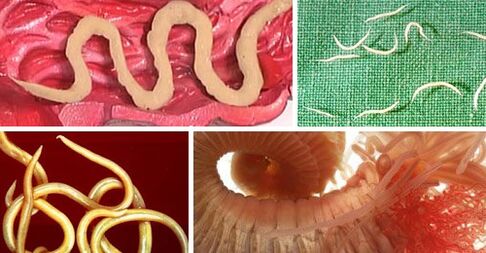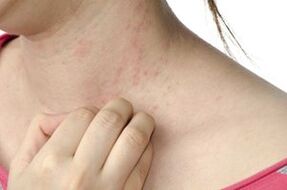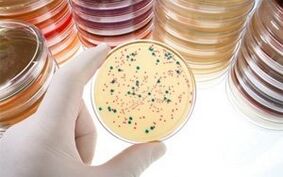
Intestinal parasites- These are helminths that parasitize within human intestines.It can be a parasite or several at the same time.The more Helminto is in the body, the more significant health worsens.For a long time, the existing polya leads to a complete exhaustion of the body.Some migratory representatives can obstruct bile ducts and cause mechanical jaundice.
Intestinal parasites list
In domestic practice, it is something conditionally common to divide all helminths into tropical and non -rropical.
Tropical parasites are found in countries with the corresponding climate in Africa, Southeast Asia.These include schistosomas, filaria, wucheria and many others.It can be infected with tropical helminths only in the territory of the corresponding country, testing local cooking dishes, using water from an unknown water supply source, neglecting the rules of sanitation and hygiene.
The infection with tropical heline of a healthy person of a sick person is impossible, since certain environmental conditions and the body of the intermediate host are necessary to complete the complete development cycle.
Currently, more than 300 parasites are known, around 100 of them are registered in the European continent.An important part of them precisely parasite in a person's intestines.

The most common version of the classification of intestinal parasites according to the structure of your body.The following classes are distinguished:
- Supers (they are also called trematodes): they have an oval shape in the form of a sheet, the main distinctive feature is the presence of suction cups;
- The tape (they are also called cestodes): it can reach a significant length (up to several meters);have the shape of a flat lace or tape;
- Round (they are also called nematodes): they differ in the corresponding form.
Among the most relevant intestinal human heline are known:
| Nematodes | Cestodo | Trematodes |
|
|
|
Each Helminto is characterized by the stages of development and the change of several owners.
Symptoms of intestinal parasites
The clinical manifestations of intestinal helminthiasis have much in common, so it is almost impossible to decide on the diagnosis before the laboratory exam.In this sense, one can distinguish an acute and chronic form of helminthiasis and describe the appropriate clinical symptoms.
Acute phase

It is characterized by a pronounced general symptoms due to the action of the parasite itself and to the response of the organs and systems of the host.Among the most significant symptoms:
- subfile temperature;
- Cutaneous eruptions of various intensity and species (spots, papules, less often pustules and hemorrhage) often in combination with itching in the skin;
- pain in the muscles and joints of a spilled nature;
- Subcutaneous skin and fat swelling;
- Abdominal syndrome (shed pain in the abdomen, nausea and repeated vomiting, long -term diarrhea without pathological impurities).
The severity of the previous clinical characteristics is individual.One person can have a slight discomfort, and the other has a strong deterioration in the state of health, which cannot go unnoticed.
Chronic phase
It occurs in the absence of proper treatment.Local (intestinal symptoms) associated with mechanical damage on the intestinal wall stands out.General clinical symptoms are less pronounced.As a result of chronic, there are helminths:
- violation of nutrient absorption;
- inhibition of metabolism processes (exhaustion, anemia);
- Some helminths cause the formation of non -ostosis.
A spontaneous cure in the chronic phase stage of Helmintiasis is almost impossible.
Characteristics of individual types of helminthiasis
Only a doctor can assume the development of one or another helminthiasis.The characteristic clinical characteristics are typical for certain types of helminths.For example:
| Intestinal Lombriz |
|
| Askarida |
|
| Tricinosis |
|
| Anylostomidosis |
|
| Tricocephalyosis | Damage to distal intestines (hemocolite); |
| Strongiloidosis | Stomach membrane atrophy and intestines; |
| Echinococcus | Mechanical jaundice as a result of the formation of an equinoctic cyst at the doors of the liver; |
| Cat bicom | Potentiation of carcinogenesis |
Confirmation of the diagnosis of one or another helminosis is possible only after a comprehensive exam.
What is the infection and development of the parasite in the body?

Infection with intestinal parasites can occur in 2 ways:
- Through the skin, the perceived path of so;
- Through dirty hands, poorly washed vegetables and fruits, water and contaminated foods.
The intestinal parasites, according to their name, do not leave the limits of the digestive channel of a person.In the future, the parasite can develop in 2 ways: simple and complex.
With a simple cycle of development of an egg, a Helminto that enters the human body, its adult individual develops.Clinical symptoms are due to damage to a particular gastrointestinal department.
With a complex development cycle, an egg larva is formed, and the parasite is migrated to several organs, which determines the variety of clinical symptoms.
Methods to diagnose parasitic intestinal diseases
For the diagnosis and treatment of intestine parasitic diseases, a specialist in medical infectious diseases should consult.In large cities there are special medical centers and even stationary departments.
The diagnosis of the helmi -invasion begins with a general clinical blood analysis: the main distinctive feature is pronounced eosinophilia, an increase in the number of eosinophils in the blood.

Among the specific research methods are known:
- The parasitological method is the detection of worms in the feces in the patient;For this, a new portion of feces under a microscope is collected and examined;If necessary, a transport environment is used to deliver to the laboratory;
- The serological method is the detection of class M immunoglobulins (acute phase);
- Instrumental methods (ultrasound, tomography): with the objective of the differential diagnosis to exclude tumor processes.
The result of only one study is not an independent diagnosis.Only a doctor can evaluate the patient's condition, only a doctor can make a preliminary diagnosis.
Treatment
The therapy of any helminthiasis should be under the control of the doctor.The independent use of antigelmic drugs (even for prevention) is unacceptable, since most drugs are quite toxic.
An integral approach is required, which includes dietary nutrition, medications and popular remedies.
Nutrition
There are no strict rules that regulate nutrition for helminthiasis.It is enough to follow the rules of the healthy diet:
- Use a sufficient amount of low fat products;
- Include a variety of porridge, egg plates, varieties of low fish and meat in the diet;
- leave alcoholic beverages;
- reduce or exclude semi -ends products, soda water, products with a high content of preservatives and flavored potentiators;
- All products must be washed thoroughly (vegetables, fruits, berries), if possible, thermally processed (blood bifsteke is not allowed) to avoid reflection.
By prescribing a particular medication, the doctor will explain individually which products should be limited or completely excluded.
Drugs
In the treatment of helminthia, universal drugs are used that destroy several types of helminths at the same time.
The duration of the treatment course is selected individually.In combination with antiparasitic drugs, hepatoprotectors and integers are used.
Worm cleaning
The use of some antihelmintic agents implies their combination with an enema.Enema, an ordinary cleaning eme, there are no characteristics.Either necessary or not, the doctor decides.
Popular recipes

The effectiveness is doubtful.Among those who are popular, they are known:
- pumpkin seeds;
- alcohol tincture made of non -selected (green) nuts;
- Banks alcohol tincture;
- Newly prepared broth made of pine cones.
A combination of popular recipes and traditional drugs is allowed.
Parasitic disease prevention
There is no specific prevention.Given the simplicity and ease of infection, it is very difficult to protect themselves from the helmi -invasion.This is necessary:
- Always wash vegetables and fruits, rinse them with boiling water;
- Avoid storage in the refrigerator with a series of products of finished and semi -final products;
- mandatory and thoroughly wash your hands;
- Follow the rules of culinary dishes.




